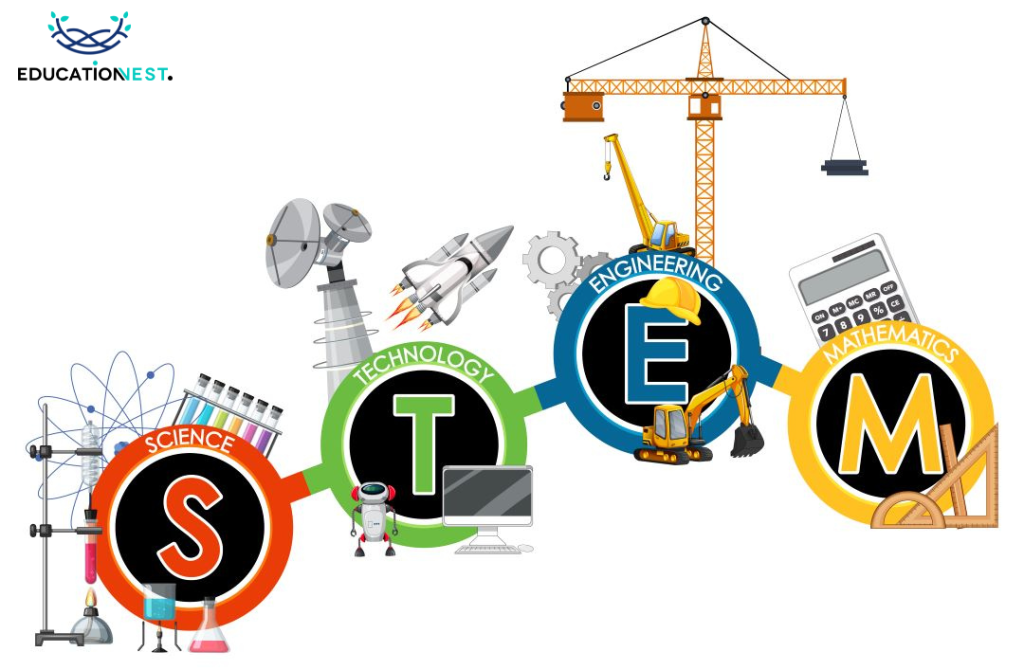
A fifth grader building a simple circuit board could make the next big discovery in technology. A high school science project on rising sea levels might inspire policies that lead to real climate change action. Future self-driving cars that get smarter may rely on graduation projects by today’s engineering students. Big innovation and progress starts small in classrooms with STEM education. STEM stands for Science, Technology, Engineering and Math. This kind of learning encourages students to be curious, work together, and solve real-world problems. It trains new generations of innovators and change makers. So what makes STEM education special, and why do we need more of it these days? Read our blog to understand what STEM learning is all about, why kids need it, and how it can shape the future.
What is STEM?

STEM education has become a hot topic in recent years, but what exactly does that term mean? STEM stands for Science, Technology, Engineering, and Mathematics. It refers to an interdisciplinary, project-based approach to learning that focuses on real-world applications of concepts taught in the four areas. The goal of STEM education is to foster inquiring minds, logical reasoning, and collaboration skills to prepare students for the future workforce.
STEM education in India has gained significant traction in the last decade though increased focus from both government and private organizations. With rapid development in technology and business landscapes, there is a growing need for STEM skills across industries in India. Exposure to quality STEM education during school and college years can set students on the right path to lucrative careers.
Benefits of STEM Education

Here are some of the key reasons why STEM education is critical:
Develops Critical Thinking and Problem-Solving Skills
STEM learning encourages students to ask questions and define real-world problems. Subjects like science and math push students to critically observe, analyze data, identify issues, and apply logic to find solutions. Developing these abilities from a young age fosters analytical and innovative minds.
Prepares Students for the Future
The world is becoming increasingly dependent on technology. From healthcare to finance to transportation, STEM knowledge is driving progress and innovation. STEM education grooms students in scientific temperament and technical capabilities to prepare them for jobs of the future. Students with STEM backgrounds will have an edge in the modern digital economy.
Boosts Employability
There is already a massive demand for engineers, data scientists, developers and technologists across sectors. This need for STEM skills will only intensify over the next decade with technologies like AI and machine learning becoming mainstream. Students equipped with STEM knowledge will have brighter career prospects and higher employability.
Multidisciplinary Learning
Unlike traditional rote learning, the STEM curriculum delivers a multidisciplinary flavor of education. For instance, a robotics class would involve design, engineering, coding as well as logical and complex problem solving. Such blended learning builds a foundation of core concepts that easily transfer across domains, while also developing well-rounded capabilities in students.

STEM Education Examples
STEM learning does not have to happen only in textbooks. Here are some hands-on examples of STEM education in action:
● Students researching climate change patterns and building models to demonstrate the impact
● An after-school robotics program allowing students to build and code robots
● A maker space with 3D printers and other tools for students to design real products
● Using data analysis of crime rates or spread of diseases to draw insights
Such experiments and programs pique student curiosity and engrain key learnings through first-hand experience. While still nascent, specialized STEM education programs are cropping up within school districts and supplemental education providers across India.
The Future of STEM

The future is digital, and the jobs of tomorrow will require some level of STEM understanding in almost every field, from media, law, healthcare to even politics. Policymakers have taken note of the promising potential of STEM and the Government of India has launched several initiatives like STEM parks, Atal Tinkering Labs and smart classrooms with a dedicated focus on STEM access and quality. However, there is still tremendous room for growth if India wants to incubate job-ready talent and bridge the skill gap compared to global economies.
Educators and parents also need a mindset shift to promote well-rounded STEM education rather than just academics. From schools being equipped with adequate lab infrastructure to a greater emphasis on critical thinking over rote learning methods in classrooms, many improvements are needed across the Indian education fabric. But with rising private participation and public urgency, India seems on track to strengthen its STEM capabilities.
Also Read:
Is Corporate Social Responsibility a Must-Have?
Exposure to topics like programming, data science, design thinking at a young age can spark lifelong interests. A student experimenting with an electronics kit might go on to major in electrical engineering and eventually invent the next revolutionary gadget! With the right guidance and learning environment, every child has the potential to become creators rather than just consumers of technology.
Conclusion

STEM education sets students up for what the future holds. As STEM pervades deeper into mainstream education, students will not only perform better academically but develop transferable abilities to logically tackle real problems. They will drive innovation, make scientific breakthroughs and lead India towards continued progress and prosperity.
As we wrap up our look into STEM education, it’s clear—it’s more than just a school subject; it’s a way of making learning an adventure. Whether it’s sparking curiosity for science, getting better at tech, or creating cool things in engineering, STEM is like a guide helping students step into a future where there are endless chances.
But why is STEM important in India and everywhere else? Think of it as a guiding light, showing the way to a future where there are no limits to what you can know. Students don’t just finish as learners; they become the designers of a smarter, more creative world.

